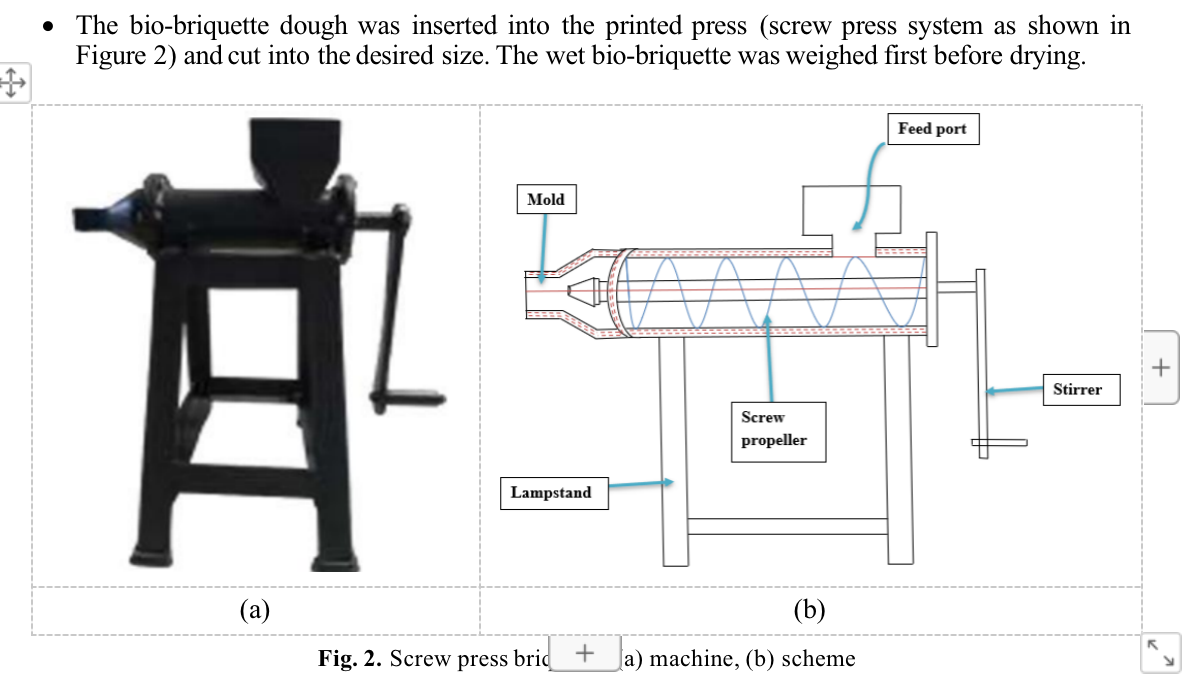Combustion Quality Analysis of Bio-Briquettes from Mixture of Coconut Shell Waste and Coal with Tapioca Flour Adhesive
DOI:
https://doi.org/10.26555/ijce.v1i1.452Keywords:
Bio-briquette, Coal, Coconut shell waste, Molding screw system, Tapioca flourAbstract
Agroindustry residues can be utilized as a resource for alternative energy sources such as bio-briquettes. Using agro-industry residue is also a solution to reduce pollution caused by biomass waste in the environment. This article highlights the combustion quality analysis of biomass waste in the form of bio-briquettes with binding materials prepared from tapioca flour. The biomass used is a mixture of coconut shell charcoal and coal to improve the quality of the bio-briquettes. In this study, bio-briquettes were manufactured using a screw press system. The combustion quality of bio-briquettes with various percentage compositions (0:100, 25:75, 50:50, 75:25, 100:0) of coconut shell charcoal and coal was investigated, i.e., moisture content, ash content, combustion rate, and calorific value. Results show that the calorific value of most bio-briquettes produced in this study was higher than the standard calorific value according to SNI Standard No.1/6235/2000 (≥ 5,000 cal/gr). The optimum composition to produce bio-briquette with good quality based on the standard is 75:25 (coconut shell charcoal: coal), which had a moisture content of 7.6325%, ash content of 6.9697%, combustion rate of 0.1833 gr/min, and caloric value of 5833.78 cal/gr.
References
I. Naruse, G. Lu, H. Kim, and J. Yuan, “Combustion Behavior and Emission Control in Biobriquette Combustion,” 1999.
Maryono, Sudding, and Rahmawati, “Pembuatan dan Analisis Mutu Briket Arang Tempurung Kelapa Ditinjau dari Kadar Kanji,” Chem. J. Ilm. Kim. dan Pendidik. Kim., vol. 14, no. 1, pp. 74–83, 2013.
Daryanto, Energi: Masalah Pemanfaatannya bagi Kehidupan Manusia. Yogyakarta: Pustaka Widyatama, 2007.
F. Widadie, “Kajian Peningkatan Mutu Briket Arang Tempurung Kelapa dengan Alat Pengering Tipe Rak Berbahan Bakar Biomassa,” J. Teknol. Has. Pertan., vol. 4, no. 1, pp. 23–26, 2013.
I. Suryani, M. Y. P. U, and M. H. Dahlan, “Pembuata Briket Arang dari Campuran Buah Bintaro dan Tempurung Kelapa Menggunakan Perekat Amilum,” J. Tek. Kim., vol. 18, no. 1, pp. 24–29, 2012.
M. Faizal, “Utilization Biomass and Coal Mixture to Produce Alternative Solid Fuel for Reducing Emission of Green House Gas,” Int. J. Adv. Sci. Eng. Inf. Technol., vol. 7, no. 3, pp. 950–956, 2017.
L. S. Pedersen et al., “Full Scale Co-Firring of Straw and Coal,” Fuel, vol. 75, no. 13, pp. 1584–1590, 1996.
B. Geologi, “Kebijakan Batubara Nasional,” Jakarta, 2014.
P. Chuenklang, S. Thungong, and T. Vitidsant, “Effect of Activation by Alkaline Solution on Properties of Activated Carbon From Rubber Wood,” J. Met. Mater. Miner., vol. 12, no. 1, pp. 29–38, 2002.
S. Jamilatun, “Sifat-Sifat Penyalaan dan Pembakaran Briket Biomassa, Briket Batubara dan Arang Kayu,” J. Rekayasa Proses, vol. 2, no. 2, p. 37, 2008.
M. Faizal, M. Saputra, and F. A. Zainal, “Pembuatan Briket Bioarang Dari Campuran Batubara dan Biomassa Sekam Padi dan Eceng Gondok,” J. Tek. Kim. Univ. Sriwij. Palembang, vol. 21, no. 4, 2015.
J. Fariadhie, “Perbandingan Briket Tempurung Kelapa dengan Ampas Tebu, Jerami dan Batu Bara,” J. Tek., vol. 5, no. 1, pp. 1–8, 2009.
D. D. Anggoro, M. H. D. Wibawa, and M. Z. Fathoni, “Pembuatan Briket Arang dari Campuran Tempurung Kelapa dan Serbuk Gergaji Kayu Sengon,” Teknik, vol. 38, no. 2, pp. 76–80, 2017.
N. Aini, S. Jamilatun, and J. Pitoyo, “Pengaruh Tipe Biomassa Pada Produk Pirolisis: A Review,” Agroindustrial Technol. J., vol. 02, no. 01, pp. 91–97, 2018.

Downloads
Published
Issue
Section
License
Copyright (c) 2023 Siti Jamilatun, Dhias Cahya Hakika, Aster Rahayu, Remmo Sri Ardiansyah, Shafa Zahira, Riska Setyarini

This work is licensed under a Creative Commons Attribution-ShareAlike 4.0 International License.



